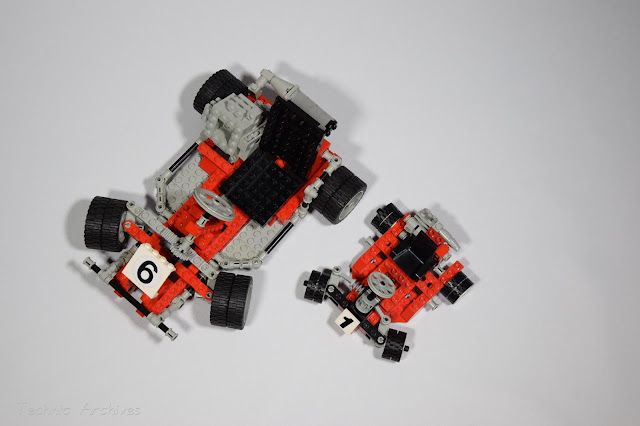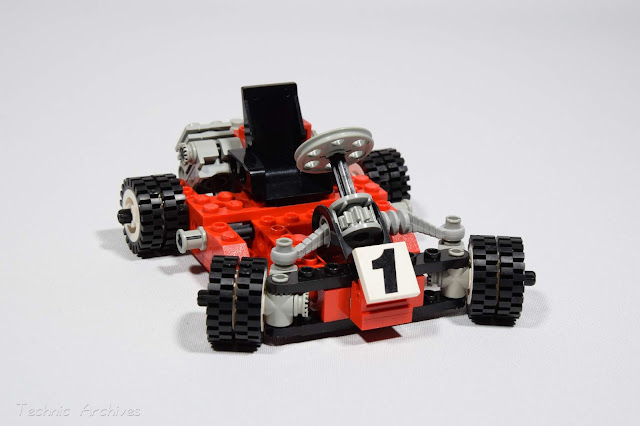Is it possible to build a go cart that not only looks like a real one, but functional too, using less than 80 pieces of Technic Lego? It certainly is, because the 8815, released in 1991 consist only 78 parts!
Go carts were always a popular theme in Technic. They were featured mostly in sets under a hundred pieces. The most extraordinary thing about this set is that there is nothing extraordinary about it: this wasn't the first set to feature a go cart (854), nor the first to implement the compact steering element (8832), nor the first to have double wheels (1972), and nor the first which looked like a real go cart (8842).
Set number: 8818
Released: 1991
Set name: Speedway Bandit
Number of pieces: 78
It is very similar to the 1972, but while it has the old, rectangular piston, 8815 was the first go cart to use the new cylindrical engine element. It is also very similar to the 8842: the shape and aspect ration of the chassis, the double wheels and the colour scheme is almost the same. Though in 8815 the driver would sit in the middle.
The first wheels are steerable by the compact steering part, which was used extensively in the '90-ies.
Don't forget the wheels, because there are 8 of them! Every axle holds double wheels, thus simulating the wide tyres of a real go cart. With adding a different, mid-sized set, one could build quite interesting vehicles from that many wheels.
There is something odd with this model, though: while the axles are protruding from their wheels, the rear left one is flush with it. The vehicle could easily be made symmetrical, if the bush were replaced with a half bush at the odd axle. I never understood why the designer decided to it this way.
The build is quite straightforward, and mostly utilises the standard studded building technique, which must be familiar from the System or City product line: putting the bricks on top of each other. This set contains only two Technic pins. It's obvious, that the youngest builders were the target audience for this set. There are only 10 steps in the building instructions, so only a few pieces are built in in a single step. Not like in the much bigger, containing more than 600 pieces (and also much older) 853 "Auto Chassis", which is build in 16 steps all together.
I built this set with my 5 years old daughter. Since I have two copies of this set, we could built the model simultaneously. Following the building instructions was a bit difficult for her, but when she was inspecting what I was doing on my model, she could successfully copy everything, and finish the build on her own. Of course she was very proud, and considered it a good experience to build something together. Despite that she had no interest in the completed model at all: I had to drive around both of them in the living-room.
Go carts were always a popular theme in Technic. They were featured mostly in sets under a hundred pieces. The most extraordinary thing about this set is that there is nothing extraordinary about it: this wasn't the first set to feature a go cart (854), nor the first to implement the compact steering element (8832), nor the first to have double wheels (1972), and nor the first which looked like a real go cart (8842).
Set number: 8818
Released: 1991
Set name: Speedway Bandit
Number of pieces: 78
It is very similar to the 1972, but while it has the old, rectangular piston, 8815 was the first go cart to use the new cylindrical engine element. It is also very similar to the 8842: the shape and aspect ration of the chassis, the double wheels and the colour scheme is almost the same. Though in 8815 the driver would sit in the middle.
Building and Functions
Despite having so few parts, there are some functionality. One could familiarise him-/herself how a reciprocal engine works (sort of), driven by one rear wheel (It would be unreal to expect a differential in a set having less than a 100 parts). There is only one cylinder, but real go carts usually have only one as well.The first wheels are steerable by the compact steering part, which was used extensively in the '90-ies.
Don't forget the wheels, because there are 8 of them! Every axle holds double wheels, thus simulating the wide tyres of a real go cart. With adding a different, mid-sized set, one could build quite interesting vehicles from that many wheels.
There is something odd with this model, though: while the axles are protruding from their wheels, the rear left one is flush with it. The vehicle could easily be made symmetrical, if the bush were replaced with a half bush at the odd axle. I never understood why the designer decided to it this way.
The build is quite straightforward, and mostly utilises the standard studded building technique, which must be familiar from the System or City product line: putting the bricks on top of each other. This set contains only two Technic pins. It's obvious, that the youngest builders were the target audience for this set. There are only 10 steps in the building instructions, so only a few pieces are built in in a single step. Not like in the much bigger, containing more than 600 pieces (and also much older) 853 "Auto Chassis", which is build in 16 steps all together.
Motorising
We get instructions on how to motorise the A model, but there is not much fantasy in it. If the button is pushed, the car goes forward. No steering. To achieve this, one needs the 8720 supplemental set. It contains the then standard 9 volt motor, but I find it dubious that somebody bought the motor set for the sheer reason to motorise this set only.
Play value
Driving the vehicle around feels like driving a real go cart: steering is direct, the wide tyres has a nice grip and the little piston happily revolves in the engine. I quite like the looks of it too: the short wheelbase and the wide chassis resembles the real thing.
This set is typically one that's more fun to play with, than building it. If there are more than one in one's possession, then a race will break out inevitably. The complete lack of a cabin means it's an easy reach for the steering wheel, even for an adult. It's also very sturdy, the chassis is stiff (because it's so small), and there are no standing out pieces. The most prone pieces to break off are the number plate and the exhaust pipe.
B model
There are building instructions for a road roller. On the front axle, there is a roller made out of 6 wheels, while the real wheels are steerable. It looks very nice, but because of the uneven weight distribution it's difficult to drive around. There is so little load on the rear axle that the real wheels are prone to slip. Then again, a real road roller usually isn't that fast either, and slipping is not so bad at a slow pace.
The road roller doesn't utilises the engine parts, that would need a longer axle, and a gear train of some sort, as the crankshaft is way too short. The engine cylinder would hit the wheels.
It is crucial to build the roller properly, as there is very little clearance for it. If it touches the supporting beams, then roller would stuck and slip. The 10 unit long axle is only about 1 mm longer than the sum width of the elements it's threading: 6 wheels, 2 beams and 2 bushes. The steering arms are basically touching the beams in front of them. I always marvel at how precise Lego pieces are designed. The always seem to be the proper length for a snug fit.
It is crucial to build the roller properly, as there is very little clearance for it. If it touches the supporting beams, then roller would stuck and slip. The 10 unit long axle is only about 1 mm longer than the sum width of the elements it's threading: 6 wheels, 2 beams and 2 bushes. The steering arms are basically touching the beams in front of them. I always marvel at how precise Lego pieces are designed. The always seem to be the proper length for a snug fit.
Impressions
I never had this set as a kid, but also I probably thought it to be boring. Up until the point, when I learned that it includes a set of instructions to build a "small supercar", if you combine this set with a 8024 and a 8820. From then on I kept asking for it, as I actually had the 8024.
Rare pieces
The small, teethed bushes are the only problematic parts; they break easily. Fortunately though, it's easy to replace them with the newer, smooth sided ones, as this set doesn't utilises the teeth at all. The smooth sided small bush is still in production today.
Summary
In my opinion, this set is a good value for money. It looks good, drives good and is cheap. But what really makes it appealing is the extra building instructions for the "mini supercar". That's the only reason I bought it, to finally be able to build it after more than 25 years of waiting.












Comments
Post a Comment